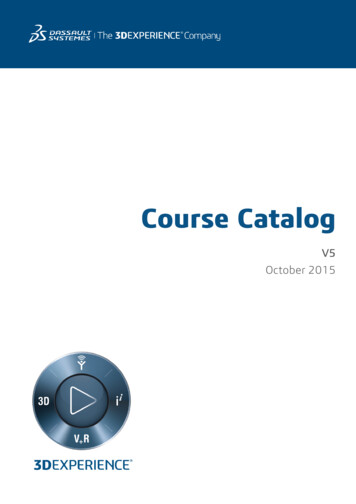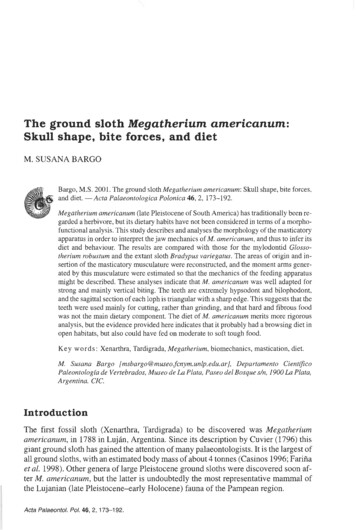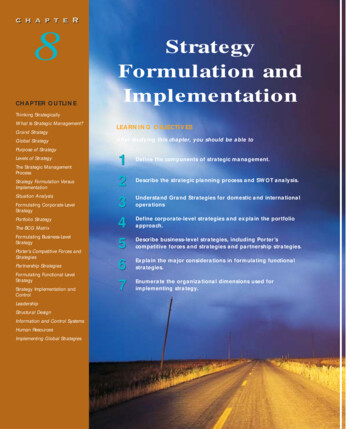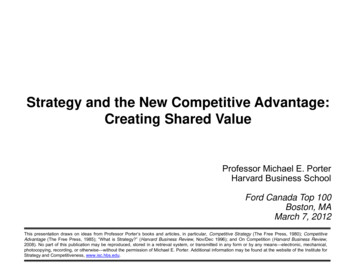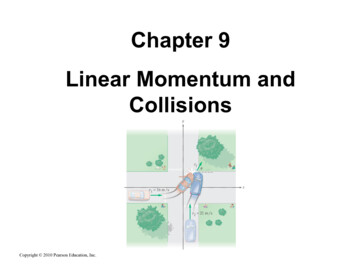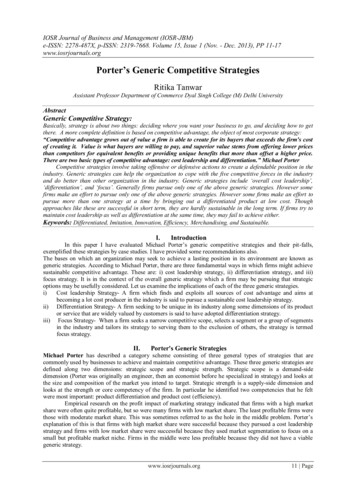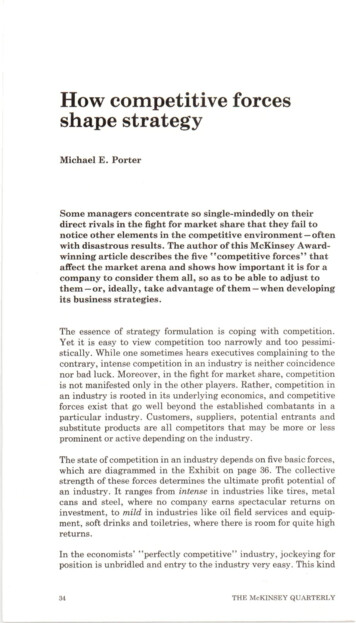
Transcription
How competitive forcesshape strategyMichael E. PorterSome managers concentrate so single-mindedly on theirdirect rivals in the fight for market share that they fail tonotice other elements in the competitive environment — oftenwith disastrous results. The author of this McKinsey Awardwinning article describes the five "competitive forces" thataflfect the market arena and shows how important it is for acompany to consider them all, so as to be able to adjust tothem —or, ideally, take advantage of them —when developingits business strategies.The essence of strategy formulation is coping with competition.Yet it is easy to view competition too narrowly and too pessimistically. While one sometimes hears executives complaining to thecontrary, intense competition in an industry is neither coincidencenor bad luck. Moreover, in the fight for market share, competitionis not manifested only in the other players. Rather, competition inan industry is rooted in its underlying economics, and competitiveforces exist that go well beyond the established combatants in aparticular industry. Customers, suppliers, potential entrants andsubstitute products are all competitors that may be more or lessprominent or active depending on the industry.The state of competition in an industry depends onflvebasic forces,which are diagrammed in the Exhibit on page 36. The collectivestrength of these forces determines the ultimate profit potential ofan industry. It ranges from intense in industries like tires, metalcans and steel, where no company earns spectacular returns oninvestment, to mild in industries like oilfieldservices and equipment, soft drinks and toiletries, where there is room for quite highreturns.In the economists' "perfectly competitive" industry, jockeying forposition is unbridled and entry to the industry very easy. This kind34THE McKINSEY QUARTERLY
of industry structure, of course, offers the worst prospect for longrun profitability. The weaker the forces collectively, however, thegreater the opportunity for superior performance.Whatever their collective strength, the corporate strategist's goalis to find a position in the industry where his or her company canbest defend itself against these forces or can influence them in itsfavor. The collective strength of the forces may be painfullyapparent to all the antagonists; but to cope with them, the strategist must delve below the surface and analyze the sources of each.For oxample, what makes the industry vulnerable to entry? Whatdetermines the bargaining power of suppliers?Knowledge of these underlying sources of competitive pressureprovides the groundwork for a strategic agenda of action. Theyhighlight the critical strengths and weaknesses of tho company,animate the positioning of the company in its industry, clarify theareas where strategic changes may yield the greatest payoff, andhighlight the places where industry trends promise to hold thegreatest significance as either opportunities or threats. Understanding these sources also proves to be of holp in consideringareas for diversification.Contending forcesThe strongest competitive force or forces determine the profitabilityof an industry and so are of greatest importance in strategy formulation. For example, even a company witb a strong position inan industry unthreatened by potential entrants will earn lowreturns if it faces a superior or a lower-cost substitute product - asthe leading manufacturers of vacuum tubes and coffee percolatorshave learned to their sorrow. In such a situation, coping with thesubstitute product becomes the number one strategic priority.Different forces take on prominence, of course, in shaping competition in each industry. In the ocean-going tanker industry thekey force is probably the buyers (the major oil companies), whilein tires it is powerful OEM buyers coupled with tough competitors.In the steel industry the key forces are foreign competitors andsubstitute materials.Every industry has an underlying structure, or a set of fundamentaleconomic and technical characteristics, that gives rise to thesocompotitive forces. The strategist, wanting to position his companyto cope best with its industry environment or to infiuence thatSPRING 1980. ,.35
ExhibitForces governing competition in an industryBargainingpower ofsuppliersBargainingpower ofcustomersThreat ofsubstitute productsor servicesenvironment in the company's favor, must learn what makes theenvironment tick.This view of competition pertains equally to industries dealing inservices and to those selling products. To avoid monotony in thisarticle, I refer to both products and services as "products." Thesame general principles apply to all types of business.A few characteristics are critical to the strength of each competitive force. I shall discuss them in this section.Threat of entryNew entrants to an industry bring new capacity, the desire to gainmarket share and, often, substantial resources. Companios diversifying through acquisition into the industry from other marketsoften leverage their resources to cause a shake-up, as PhilipMorris did with Miller beer. The seriousness of the threat of entrydepends on the barriers present and on the reaction from existingcompetitors that the entrant can expect. If barriers to entry arehigh and a newcomer can expect sharp retaliation from the entrenched competitors, obviously he will not pose a serious threat ofentering.36THE McKINSEY QUARTERLY
There are six major sources of barriers to entry:1. Economies of scale. These economies deter entry by forcing theaspirant either to come in on a large scale or to accept a costdisadvantage. Scale economies in production, research, marketingand service are probably the key barriers to entry in the mainframecomputer industry, as Xerox and GE sadly discovered. Economiesof scale can also act as hurdles in distribution, utilization of thesales force, financing and nearly any other part of a business.2. Product differentiation. Brand identification creates a barrier byforcing entrants to spend heavily to overcome customer loyalty.Advertising, customer service, being first in tho industry andproduct differences aro among the factors fostering brand identification. It is perhaps the most important entry barrier in softdrinks, over-the-counter drugs, cosmetics, investment bankingand public accounting. To create high fences around their businesses, brewers couple brand identification with economies ofscale in production, distribution and markoting.3. Capital requirements. The need to invest large financial resourcesin order to compete creates a barrier to entry, particularly if thecapital is required for unrecoverable expenditures in up-frontadvertising or R&D. Capital is necessary not only for fixed facilitiesbut also for customer credit, inventories and absorbing start-uplosses. While major corporations have the financial resources toinvade almost any industry, the huge capital requirements incertain fields, such as computer manufacturing and mineralextraction, limit the pool of likely entrants.4. Cost disadvantages independent of size. Entrenched companiesmay have cost advantages not available to potential rivals, nomatter what their size and attainable economies of scale. Theseadvantages can stem from the effects of the learning curve (and ofits first cousin, tho experience curve), proprietary technology,access to the best raw materials sourcos, assets purchased at preinfiation prices, government subsidies, or favorable locations.Sometimes cost advantages are legally enforceable, as they arethrough patents. (For an analysis ofthe much-discussed experiencecurve as a barrier to entry, see the ruled insert on pages 38-41.)5. Access to distribution channels. The new boy on the block must,of course, secure distribution of his product or service. A new foodproduct, for example, must displace others from the supermarketshelf via price breaks, promotions, intense selling efforts, or someSPRING 1980
other means. The more limited the wholesale or retail channels areand the more existing competitors have these tied up, the tougherentry into the industry will be. Sometimes this barrier is so highthat, to surmount it, a new contestant must create its own distribution channels, as Timex did in the watch industry in the 1950s.6. Government policy. The government can limit or even forecloseentry to industries with such controls as license requirements andlimits on access to raw materials. Regulated industries liketrucking, liquor retailing and freight forwarding are noticeableexamples; more subtle government restrictions operate in fields likeski-area development and coal mining. Government also can play amajor indirect role by affecting entry barriers through controlssuch as air and water pollution standards and safety regulations.The potential rival's expectations about the reaction of existingcompetitors also will infiuence its decision on whether to enter.The company is likely to have second thoughts if incumbents havepreviously lashed out at new entrants or if:li The incumbents possess substantial resources to fight back,including excess cash and unused borrowing power, productivecapacity, or clout with distribution channels and customers.The experience curve as an entry barrierIn reeent years, the experience curve has become widely discussed as a keyelement of industry structure. According to this concept, unit costs inmany manufacturing industries (some dogmatic adherents say in allmanufacturing industries) as well as in some service industries declinewith ''experience,' or a particular company's cumulative volume ofproduction. (The experience curve, which encompasses many factors, is abroader concept than the better-known learning curve, which refers to theefficiency achieved over time by workers through much repetition.)The causes of the decline in unit costs are a combination of elements,including economies of seale, the learning curve for labor and capital-laborsubstitution. The cost decline creates a barrier to entry because new competitors with no "experience" face higher costs than established ones,particularly the producer with the largest market share, and have difficultycatching up with the entrenched competitors.Adherents of the experience-curve concept stress the importance ofachieving market leadership to maximize this barrier to entry, and they38THE McKINSEY QUARTERLY
t The incumbents seem likely to cut prices because of a desire tokeep market shares or because of industry-wide excess capacity.TI Industry growth is slow, affecting its ability to absorb the newarrival and probably causing the financial performance of all theparties involved to decline.From a strategic standpoint there are two important additionalpoints to note about the threat of entry.First, it changes, of course, as these conditions change. Theexpiration of Polaroid's basic patents on instant photography, forinstance, greatly reduced its absolute cost entry barrier built byproprietary technology. It is not surprising that Kodak plungedinto the market. Product differentiation in printing has all butdisappeared. Conversely, in the auto industry economies of scaleincreased enormously with post-World War II automation andvertical integration - virtually stopping successful new entry.Second, strategic decisions involving a large segment of an industrycan have a major impact on the conditions determining tbe threatof entry. For example, the actions of many US wine producers inthe 1960s to step up product introductions, raise advertising levelsrecommend aggressive action to achieve it, such as price cutting in anticipation of falling costs in order to build volume. For the combatant that cannotachieve a healthy market share, the prescription is usually: "Get out.''Is the experience curve an entry barrier on which strategies should bebuilt? The answer is: not in every industry. In fact, in some industries,building a strategy on the experience curve can be potentially disastrous.That costs decline with experience in some industries is not news tocorporate executives. The significance of the experience curve for strategydepends on what factors are causing the decline.If costs are falling beeause a growing company can reap economies ofscale through more efficient, automated facilities and vertical integration,then the cumulative volume of production is unimportant to its relativecost position. Here the lowest-cost producer is the one with the largest,most efficient facilities.A new entrant may well be more efficient than the more experiencedcompetitors; if it has built the newest plant, it will face no disadvantage inhaving to catch up. The strategic prescription: "You must have the largest,C'ontinued un page 40L SPRING 198039
and expand distribution nationally surely strengthened the entryroadblocks by raising economies of scale and making access todistribution channels more difficult. Similarly, decisions bymembers of the recreational vehicle industry to vertically integratein order to lower costs have greatly increased the economies ofscale and raised the capital cost barriers.Powerful suppliers and huyersSuppliers can exert bargaining power on participants in an industryby raising prices or reducing the quality of purchased goods andservices. Powerful suppliers can thereby squeeze profitability out ofan industry unable to recover cost increases in its own prices. Byraising their prices, soft-drink concentrate producers have contributed to the erosion of profitability of bottling companies becausethe bottlers, facing intense competition from powdered mixes,fruit drinks and other beverages, have limited freedom to raisetheir prices accordingly. Customers likewise can force down prices,demand higher quality or more service, and play competitors offagainst each other - all at the expense of industry profits.The power of each important supplier or buyer group depends on anumber of characteristics of its market situation and on the relativemost efficient plant," is a lot different from: "You must produce thegreatest cumulative output of the item to get your costs down."Whether a drop in costs with cumulative (not absolute) volume erects anentry barrier also depends on the sources of its decline. If costs go downbecause of technical advances known generally in the industry or beeauseofthe development of improved equipment that can be copied or purchasedfrom equipment suppliers, the experience curve is no entry barrier at all in faet, new or less experienced competitors may actually enjoy a costadvantage over the leaders. Free of the legacy of heavy past investments,the newcomer or less experienced competitor can purchase or copy thenewest and lowest-cost equipment and technology.If, however, experience can be kept proprietary, the leaders will maintaina cost advantage. But new entrants may require less experience to reducetheir costs than the leaders needed. All this suggests that the experieneecurve can be a shaky entry barrier on which to build a strategy.While spaee does not permit a complete treatment here, I want to mentiona few other elements that are quite crucial in determining the appro-40THE McKINSEY QUARTERLY
importance of its sales or purchases to the industry compared withits overall business.A supplier group is powerful if:1. It is dominated by a few companies and is more concentrated thanthe industry it sells to.2. Its product is unique or at least differentiated, or if it has built upswitching costs. Switching costs are fixed costs buyers face inchanging suppliers. These arise because, among other things, abuyer's product specifications tie it to particular suppliers, it hasinvested heavily in specialized ancillary equipment or in learninghow to operate a supplier's equipment (as in computer software),or its production lines are connected to the supplier's manufacturing facilities (as in some manufacture of beverage containers).3. It is not obliged to contend with other products for sale to theindustry. Eor instance, the competition between the steel companiesand the aluminum companies to sell to the can industry checks thepower of each supplier.4. It poses a credible threat of integrating forward into thepriateness ofa strategy built on the entry barrier provided by the experienceeurve: " The height of the barrier depends on how important eosts are to competition compared with other areas like marketing, selling and innovation.t The barrier can be nullified by product or process innovations leadingto a substantially new technology and thereby creating an entirely newexperience curve.* New entrants can leapfrog the industry leaders andalight on the new experience curve, to which those leaders may be poorlypositioned to jump.H / / more than one strong company is building its strategy on the experience curve, the consequences can be nearly fatal. By the time only onerival is left pursuing sueh a strategy, industry growth may have stoppedand the prospects of reaping the spoils of victory long since evaporated.* For an example drawn from the history of the automobile industry, see William J.Abernathy and Kenneth Wayne,' 'TheLimits of the Learning Curve," Harvard BusinessReview, September-October 1974, p.lO9.SPRING 198041
industry's business. This provides a check against the industry'sability to improve the terms on which it purchases.5. The industry is not an important customer ofthe supplier group.If the industry is an important customer, suppliers' fortunes will beclosely tied to the industry, and they will want to protect theindustry through reasonable pricing and assistance in activitieslike R&D and lobbying.A buyer group is powerful if:1. It is concentrated or purchases in large volumes. Large-volumebuyers are particularly potent forces if heavy fixed costs characterize the industry - as they do in metal containers, corn refining andbulk chemicals, for example - raising the stakes to keep capacityfilled.2. Tho products it purchases from tho industry aro standard orundifforentiatod. The buyors, sure that they can always find alternative suppliers, may play one company against another, as theydo in aluminum extrusion.3. The products it purchases from the industry form a component ofits product and represent a significant fraction of its cost. Thebuyers are likely to shop for a favorable price and purchase selectively. Where tho product sold by the industry in question is a smallfraction of buyers' costs, buyers are usually much less pricesensitive.4. Tt earns low profits, which create great incentive to lower itspurchasing costs. Highly profitable buyors, howovor, aro generallyless price sensitive (that is, of courso, if the item does not representa large fraction of their costs).5. The industry's product is unimportant to the quality of thebuyers' products or services. Where the quality of the buyers'products is vory much affocted by the industry's product, buyersare gonorally less price sensitive. Industries in which this situationobtains include oil-field equipment, where a malfunction can leadto large losses, and enclosures for electronic medical and testinstruments, whore the quality of the enclosure can infiuence thousor's improssion about the quality ofthe equipment inside.6. Tho industry's product does not save the buyer monoy. Wherethe industry's product or sorvice can pay for itself many times over.42THE McKINSEY QUARTERLY
the buyer is rarely price sensitive; rather, he is interested in quality.This is true in services like investment banking and public accounting, where errors in judgment can be costly and embarrassing, andin businesses like the logging of oil wells, where an accurate surveycan save thousands of dollars in drilling costs.7. The buyors pose a credible threat of integrating backward tomake the industry's product. The Big Three auto producers andmajor buyers of cars have often used the threat of self-manufactureas a bargaining lever. But sometimes an industry engenders athreat to buyers that its members may integrate forward.Most of these sourcos of buyer power can be attributed to consumersas a group as well as to industrial and commercial buyers; only amodification of tho frame of reference is necessary. Consumers tondto be more price sensitive if they are purchasing products thatare undifferentiated, expensive relative to their incomes, and of asort whoro quality is not particularly important. The buying powerof retailers is determined by the same rulos, with one importantaddition. Retailers can gain significant bargaining power overmanufacturers when they can infiuence consumers' purchasingdecisions, as tbey do in audio components, jewelry, appliances,sporting goods and other goods.A company's choice of suppliers to buy from or buyer groups to sellto should be viewed as a crucial strategic decision. A company canimprove its strategic posture by finding suppliers or buyers whopossess the least power to infiuenco it adversely. Most common isthe situation of a company being able to choose whom it will sell to- in other words, buyer selection. Rarely do all the buyer groups acompany sells to enjoy equal power. Even if a company sells to asingle industry, segments usually exist within that industry thatexercise less power (and that are therefore less price sensitive) thanothers. For example, the replacement market for most products isless price sensitive than the overall market.As a rule, a company can sell to powerful buyers and still comeaway with above-average profitability only if it is a low-costproducer in its industry or if its product enjoys some unusual, if notunique, features. In supplying large customers with electric motors,Emerson Electric earns high returns because its low-cost positionpermits the company to meet or undercut competitors' prices.If the company lacks a low-cost position or a unique product,selling to everyone is self-defeating because the more sales itSPRING 198043
achieves, the more vulnerable it becomes. The company may haveto muster the courage to turn away business and sell oniy to lesspotent customers. Buyer selection has been a key to the success ofNational Can and Crown Cork & Seal. They focus on the segmentsof the can industry where they can create product differentiation,minimize the threat of backward integration and otherwise mitigatethe awesome power of their customers. Of course, some industriesdo not enjoy the luxury of selecting ''good" buyers.As the factors creating supplier and buyer power change with timeor as a result of a company's strategic decisions, naturally thepower of these groups rises or declines. In the ready-to-wearclothing industry, as the buyors (dopartment stores and clothingstores) have become more concentrated and control has passed tolarge chains, the industry has come under increasing pressure andsuffered falling margins. The industry has been unable to differentiate its product or engender switching costs that lock in its buyersenough to neutralize these trends.Substitute productsBy placing a ceiling on prices it can charge, substitute products orservices limit the potential of an industry. Unless it can upgradethe quality of the product or difforontiate it somehow (as viamarkoting), tho industry will suffer in earnings and possibly ingrowth. Manifestly, the more attractive the price-performancetradeoff offered by substitute products, the firmer the lid placed onthe industry's profit potential. Sugar producers confronted withthe largo-scale commercialization of high-fructose corn syrup, asugar substitute, are learning this lesson today.Substitutes not only limit profits in normal times; they also reducethe bonanza an industry can reap in boom times. In 1978 theproducers of fiberglass insulation enjoyed unprecedented demandas a result of high energy costs and severe wintor weather. But theindustry's ability to raise prices was tempered by the plethora ofinsulation substitutes, including cellulose, rock wool and styrofoam. These substitutes are bound to become an even strongerforce once the current round of plant additions by fiberglassinsulation producers has boosted capacity enough to meet demand(and then some).Substitute products that deserve the most attention strategicallyare those that (a) are subject to trends improving their priceperformance tradeoff with the industry's product, or (b) are44THE McKINSEY QUARTERLY
produced by industries earning high profits. Substitutes oftencome rapidly into play if some development increases competitionin their industries and causes price reduction or performanceimprovement.Jockeying for positionRivalry among existing competitors takes the familiar form ofjockeying for position - using tactics like price competition,product introduction and advertising slugfests. Intense rivalry isrelated to the presence of a number of factors:1. Competitors are numerous or are roughly equal in size and power.In many US industries, of course, foreign contenders have becomepart of the competitive picture in recent years.2. Industry growth is slow, precipitating fights for market sharethat invoTve expansion-minded members.3. The product or service lacks differentiation or switching costs,which Tock in buyers and protect one combatant from raids on itscustomers by another.4. Fixed costs are high or the product is perishable, creating strongtemptation to cut prices. Many basic materials businesses, likepaper and aluminum, suffer from this problem when demandslackens.5. Capacity is normally augmented in large increments. Suchadditions, as in the chlorine and vinyl chloride businesses, disruptthe industry's supply-demand balance and often lead to periods ofovercapacity and price cutting.6. Exit barriers are high. Exit barriers, like very specialized assetsor management's loyalty to a particular business, keep companiescompeting even though they may be earning low or even negativereturns on investment. Excess capacity remains functioning andthe profitability of the healthy competitors suffers as the sick oneshang on. If the entire industry suffers from overcapacity, it mayseek government help - particularly if foreign competition ispresent.7. The rivals are diverse in strategies, origins and "personalities."They have different ideas about how to compete and continuallyrun head-on into oach other in the process.SPRING 198045
As an industry matures, its growth rate changes, resulting indeclining profits and (often) a shakeout. In the booming recreational vehicle industry of the early 1970s, neariy every producerdid well; but sTow growth since then has eTiminated the highreturns, except for the strongest members, not to mention many ofthe weaker companies. The same profit story has been pTayed outin industry after industry - snowmobiTes, aerosol packaging andsports equipment are just a few examples.An acquisition can introduce a very different personality to anindustry, as has been the case with Black & Decker's takeover ofMcCuTTough, the producer of chain saws. TechnoTogicaT innovationcan boost the TeveT of fixed costs in the production process, as in theshift from batch to continuous-line photo finishing in the 1960s.While a company must live with many of these factors - becausethey are built into industry economics - it may have some latitudefor improving matters through strategic shifts. For example, itmay try to raise buyers' switching costs or increase productdifferentiation. A focus on selling efforts in the fastest-growingsegments of the industry or on market areas with the lowest fixedcosts can reduce the impact of industry rivalry. If it is feasible, acompany can try to avoid confrontation with competitors havinghigh exit barriers and can thus sidestep involvement in bitterprice cutting.Formulation of strategyOnce the corporate strategist has assessed the forces affectingcompetition in his industry and their underlying causes, he canidentify his company's strengths and weaknesses. The crucialstrengths and weaknesses from a strategic standpoint are thecompany's posture vis-a-vis the underlying causes of each force.Where does it stand against substitutes? Against the sources ofentry barriers?Then the strategist can devise a plan of action that may include(1) positioning the company so that its capabilities provide the bestdefense against the competitive force; and/or (2) infiuencing thebalance of the forces through strategic moves, thereby improvingthe company's position; and/or (3) anticipating shifts in the factorsunderlying the forces and responding to them, with the hope ofexploiting change by choosing a strategy appropriate for the newcompetitive balance before opponents recognize it. I shall considereach strategic approach in turn.46THE McKINSEY QUARTERLY
Positioning the companyThe first approach takes the structure of the industry as given andmatches the company's strongths and weaknesses to it. Strategycan be viewed as building defenses against the competitive forcesor as finding positions in the industry where the forces are weakest.Knowledge of the company's capabilities and of the causes of thecompetitive forces will highlight the areas where the companyshould confront competition and where avoid it. If the company isa low-cost producer, it may choose to confront powerful buyerswhile it takes care to sell them onTy products not vulnerable tocompetition from substitutes.The success of Dr. Pepper in the soft drink industry iTlustrates thecoupling of realistic knowledge of corporate strengths with soundindustry analysis to yield a superior strategy. Coca-Cola and PepsiCola dominate Dr. Pepper's industry, where many small concentrate producers compete for a piece ofthe action. Dr. Pepper chosea strategy of avoiding the largest-selling drink segment, maintaining a narrow fiavor line, forgoing the development of a captivebottler network and marketing heavily. The company positioneditself so as to be least vulnerabTe to
How competitive forces shape strategy Michael E. Porter Some managers concentrate so single-mindedly on their direct rivals in the fight for market share that they fail to notice other elements in the competitive environment — often with disastrous results. The author of this McKinsey Award-winning art
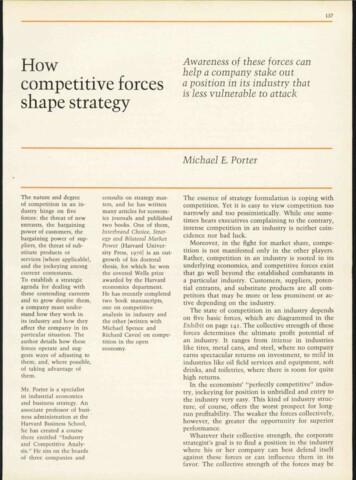
![05[2] Strategy competitors, competitive rivalry .](/img/2/052-strategy-competitors-competitive-rivalry-competitive-behavior-and-competitive-dynamics.jpg)
